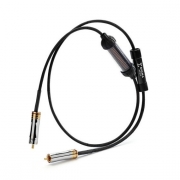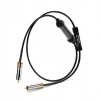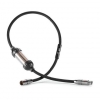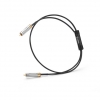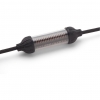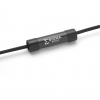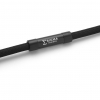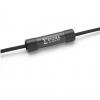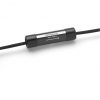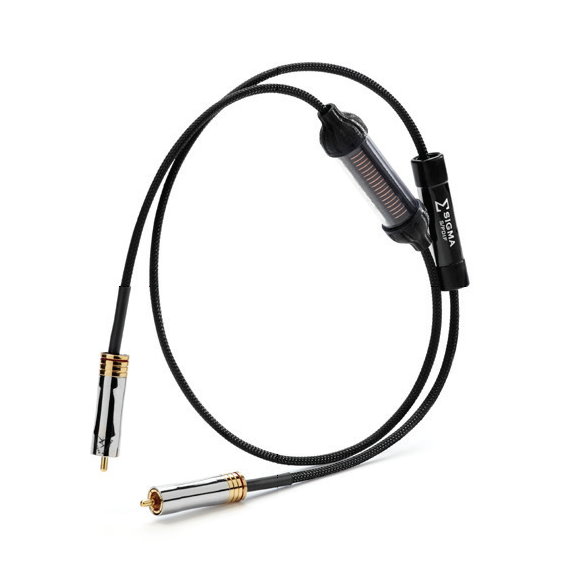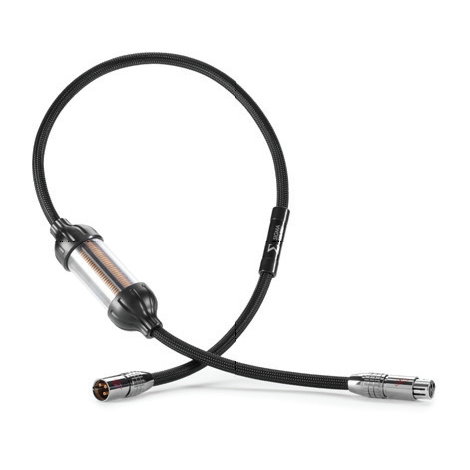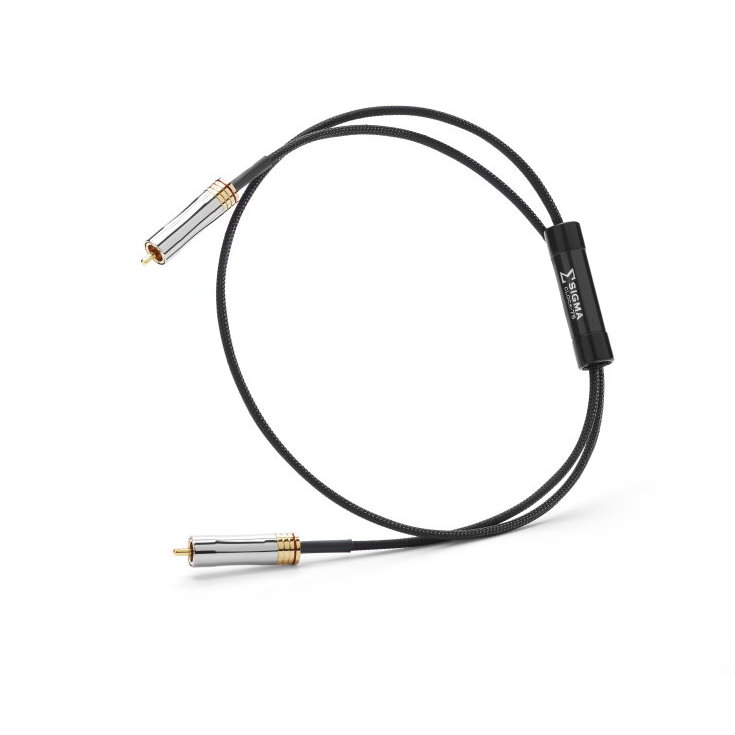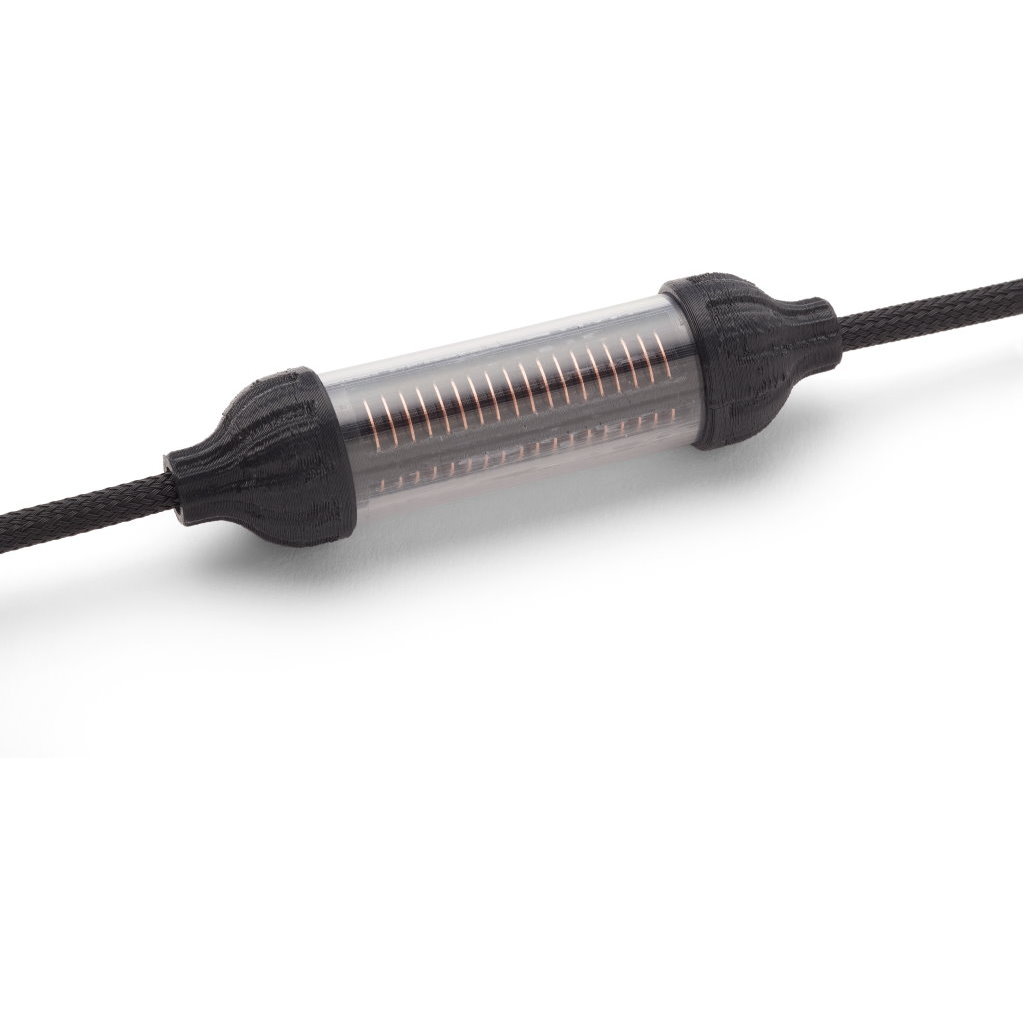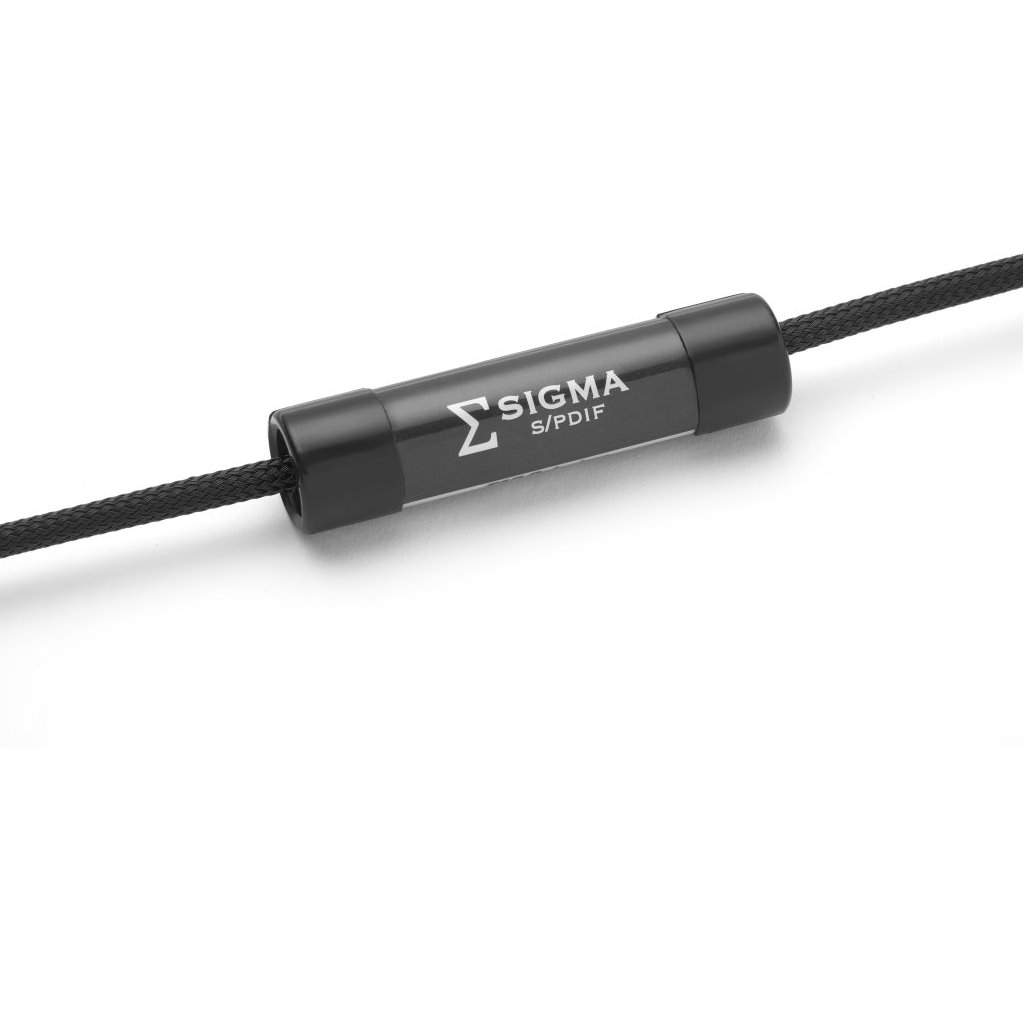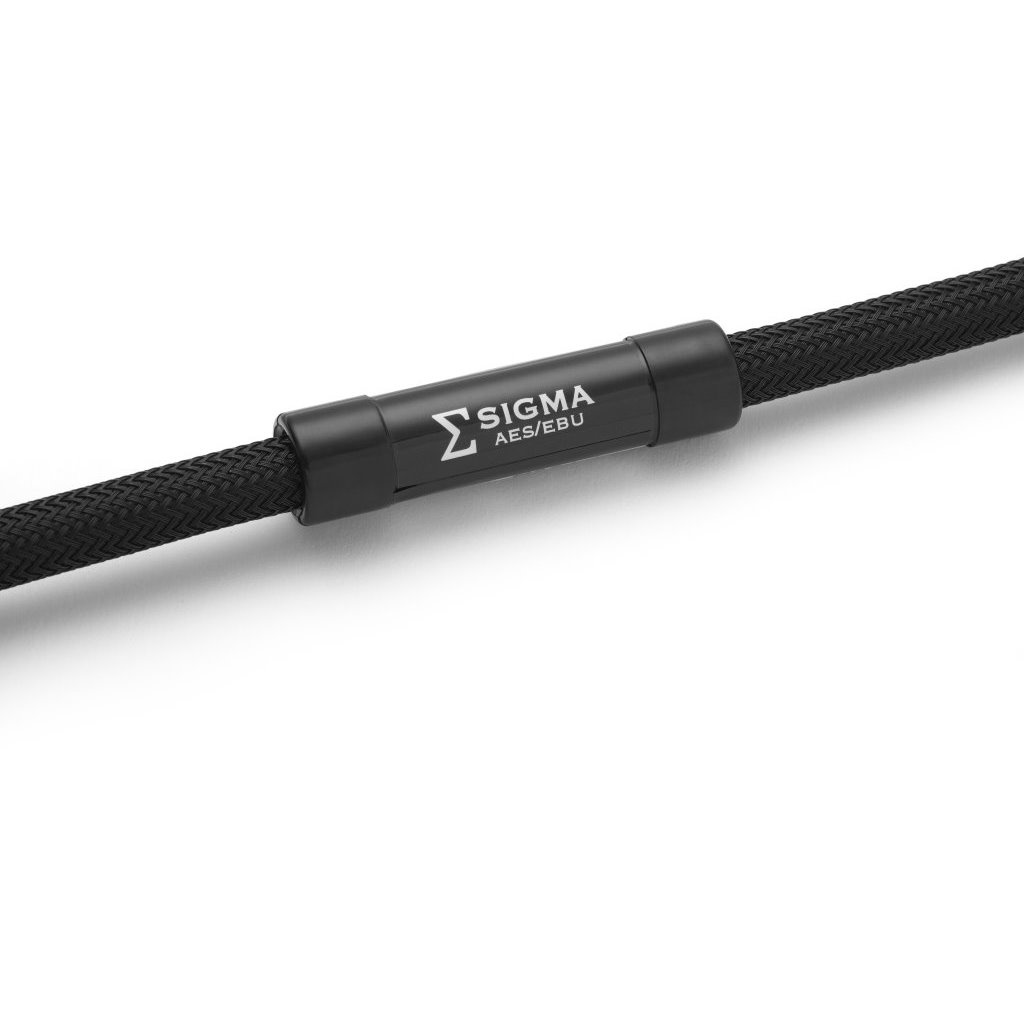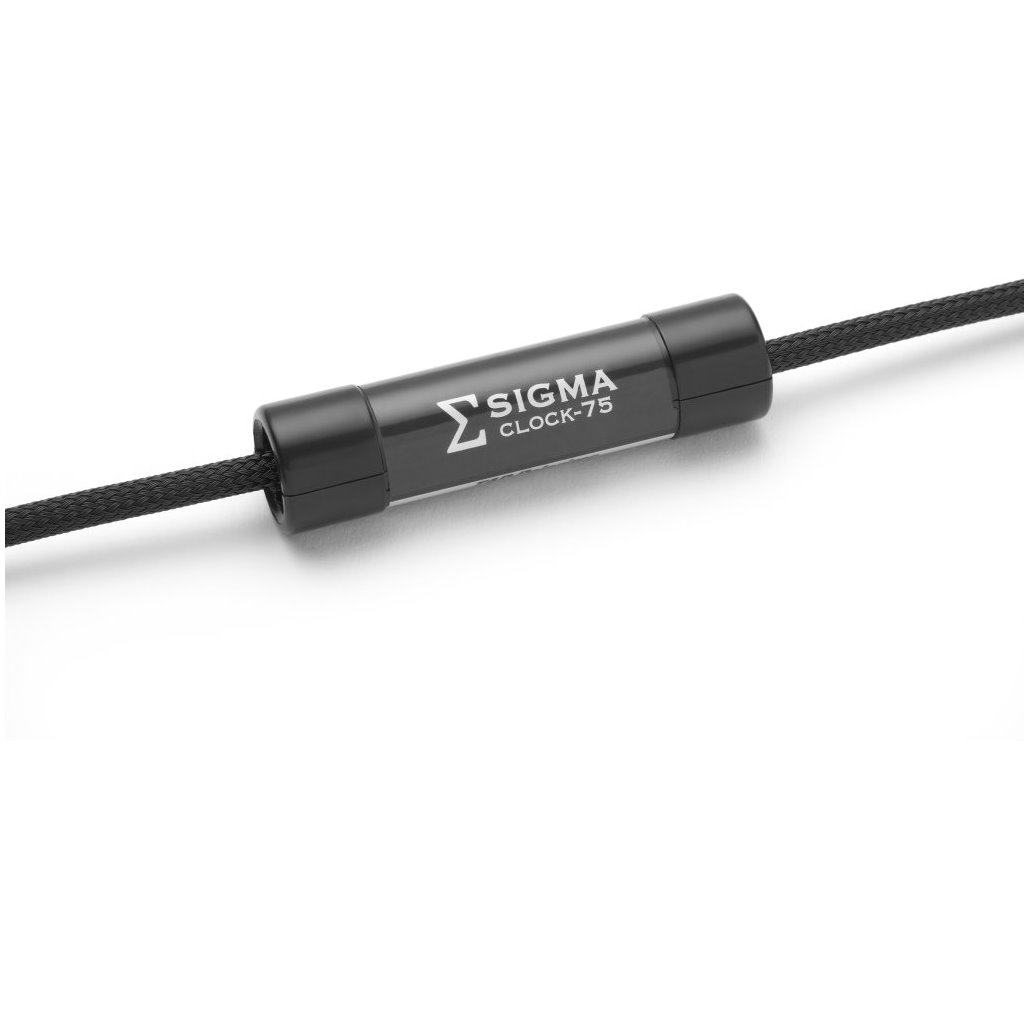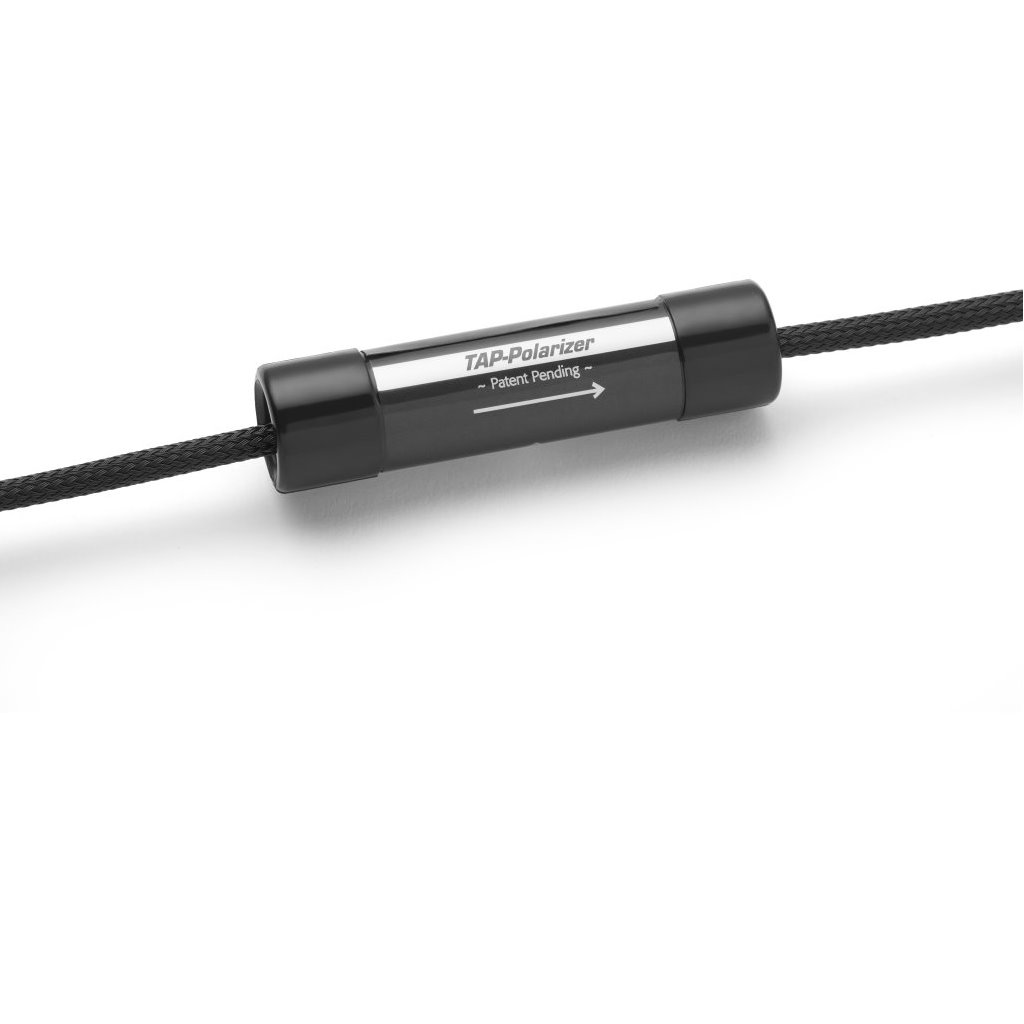- AUDIO ONE-TO-ONE Call Now: 210-805-9927
- Contact
- Register
- My Account
Shunyata Sigma Series Digital Cables
Shunyata Sigma Series Digital Cables
Shunyata Sigma Series Digital Cables
Description

MY TAKE: Simply put, Shunyata Sigma cables are the best performing cable products I have ever experienced. They offer an other-worldy level of performance that is truly extraordinary. Whether it be the Sigma power cables, interconnects, speaker cables or digital links, Sigma products can elevate even the best systems to new levels of resolution and musical involvement. For those with the means, I can't recommend a product more strongly. - Galen Carol
As the performance vanguard in the Shunyata Research cable line-up, SIGMA SERIES cables take the term state-of-the-art to an entirely new level with the introduction of two new cutting-edge
technologies. Sigma Series interconnects include the Transverse Axial Polarizer (TAP) that minimizes a form of micro-distortion identified as electromagnetic polarization. The Sigma Series
speaker cables incorporate a proprietary device called HARP that reduces current resonances within the cable, a concept that is somewhat analogous to diffraction in room acoustics. ~ Patents Pending ~
“The Sigma AES/EBU is the first digital cable I’ve heard that significantly narrows the gap between analog and digital. When I asked Gabriel what made the Sigma different, he explained that it was the culmination of a years-long quest to correlate what people hear in real, live music and design parameters like timing, velocity, total resistance, impedance and jitter. "Think of a digital cable as being like a table. The data is a ball you want to roll across that table as smoothly as possible. Imperfections are what cause things like jitter." With the Sigma, Gabriel says, he’s worked to make that table as much like glass as possible. Other cables, Gabriel contends, "are more like wood, with divots and rough sections." – Vance Hiner, The Audio Beat
Sigma – A Convergence of Science and Art -
Sigma Series cables showcase technological innovation and design execution that simply does not exist elsewhere — at any price. Sigma Series cables combine meaningful parts innovations with objective measurement and an artisan’s eye for construction quality. Unlike many cost-no-object cable products that have little in the way of discernible science, Sigma Series products incorporate an array of definable technologies that sets the standard for quality and performance in the cable industry.
Sigma Digital Cables -High-speed digital transmission is very different from audio frequency signal transmission and requires a different knowledge base and design criteria. Audio cable signal transmission is governed by the principles of inductance, capacitance, and resistance. By contrast, high-speed digital signals are governed by a principle known as ‘transmission line theory’. The performance of a transmission line is governed by the characteristic impedance of the cable. Certain types of cable require a specific characteristic impedance to achieve optimal performance — for instance, cable TV coaxial cables are 75 ohms, while test equipment cables require 50 Ohm cables. Modern audio and entertainment systems may have multiple digital connections, each with potentially different characteristic impedances. While the characteristic impedance is a critical factor in the optimal performance of digital cables, our research also indicates that the precision with which a digital cable is constructed has a significant impact on its performance.
Shunyata Research digital cables are produced using a Precision Matched Z concept. This dictates that tolerances of the conductor surface, dielectric extrusion, and the precision of the braided shield are held to smaller variances. To achieve these tight tolerances, the extrusion and braiding machines must be run at one-quarter speed during the manufacturing process. The result is better performance through a reduction of cable-induced ‘signal jitter’.
Superficially, digital cables may look the same as analog cables. For example, a S/PDIF cable can be terminated with RCA connectors, much like analog interconnects. Because the terminations appear the same, analog interconnects could be used as a substitute for a digital cable; but since it has not been designed with the correct characteristic impedance, the performance will suffer.
Sigma USB -
TAP reduces electromagnetic polarization distortion. Sigma USB cables feature Precision Matched Z conductors. Signal and power wires are heavily shielded for superior noise immunity. Each Sigma USB cable is handmade.Sigma S/PDIF -
Sigma digital cables are constructed using Precision Matched Z to reduce jitter and signal reflections. Expensive fluorocarbon dielectrics and impedance matched connectors ensure reference performance. TAP reduces electromagnetic polarization distortion.Sigma AES/EBU -
Sigma interconnects feature Shunyata Research’s exclusive patent-pending TAP Polarizer technology. TAP reduces electromagnetic polarization distortion. Ohno Continuous Cast Copper and VTXTM (hollow core) conductors with expensive fluorocarbon dielectrics make for a true reference quality interconnect.Sigma Clock 75 -
Sigma digital cables are constructed using Precision Matched Z to reduce jitter and signal reflections. Expensive fluorocarbon dielectrics and impedance matched connectors ensure reference performance. TAP reduces electromagnetic polarization distortion.Shunyata Technology – Cable Products
Highest Purity Copper -
Shunyata Research uses only the highest purity of copper available for the production of its wire products. OFE Alloy 101 or C10100 is the highest grade of copper with a minimum 99.99% purity and a conductivity rating of 101% IACS. OFE stands for oxygen-free electrolytic and supersedes the term OFHC (oxygen-free high conductivity). C10100 is the only grade of copper that comes with a written certification of purity. Certified by ASTM F68 C10100.
Single Crystal Technology -
Ohno wire, also called PCOCC was invented in 1986 by professor Atsumi Ohno of the Chiba Institute of Technology in Japan. Copper wire is created by an extrusion process that pulls a rod of cold copper through a small orifice which creates multiple crystalline boundaries. By contrast, Ohno wire is made by a process using heated molds that cast a wire to form a single crystalline structure. Ohno wire is well known for its exceptionally pure, grain-free sonic qualities.
VTX Conductor Design -
Shunyata Research’s exclusive VTXTM conductors are made in the shape of hollow tubes. Since current can ‘only’ travel through the outer rim on the wire, there are no skin effects or random eddy currents. VTXTM conductors are made from pure OFE C10100 or Ohno (single crystal) copper.
KPIP Conditioning -
KPIPTM (Kinetic Phase Inversion Process) was developed by Caelin Gabriel after years of research into the underlying causes of various effects such as burn-in, wire directionality and the effects of cryogentic treatment. He discovered that there was an underlying core principle that burn-in and cryogenics only “partially” addressed. Once the governing principle was understood it became possible to create a processing technique and machine that could virtually eliminate the need for burn-in and cryogenic treatment.Unique Conductor -
ArNi® is a type of wire created by Shunyata Research designed to be the finest quality wire available for audio purposes. It begins with the highest purity of copper available – OFE C0100 or Ohno (single crystal). Then it is formed in virtual hollow tubes eliminating skin effects and eddy current distortions. In addition, the wire undergoes our proprietary KPIPTM process.
Patented ΞTRON® -
ΞTRON® is a technology developed by Shunyata Research that prevents dielectric absorption and re-radiation in signal transmission. It requires a special type of conductor that has two signal paths and an electric field compensation circuit that creates a cancellation signal that prevents the insulation from developing a charge. ΞTRON® cables preserve the integrity of the source signal even when using very long runs of cable. Patent US 8,912,436, Patent Ch ZL201180047344.2.
Custom Connectors -
Many audiophile grade connectors are made from brass or bronze. While some may get a plating of silver, gold or rhodium, the majority of the current is carried by the contact’s base-metal. CopperCONN® connectors contain pure copper contacts which has a much higher conductivity that brass. The difference in performance is clearly audible.
TAP -
TAP (Transverse Axial Polarizer) is a device that interacts with the electromagnetic field generated by the signal traveling along the signal cable. TAP improves the sonic performance of the cable by modifying the behavior of the electromagnetic wave that surrounds the signal cable. In effect, the TAP blocks longitudinal-oriented waves while passing transverse oriented waves. The effect in sonic terms is like using polarized sunglasses to reduce reflected sunlight. Correcting polarization micro-distortion reduces what some call sonic glare. ~ Patent Pending ~
Precision Matching -
Shunyata Research digital cables are produced using a Precision Matched Z (PMZ) concept. This means that tolerances of the conductor surface, dielectric extrusion, and the precision of the braided shield are held to minute variances. To achieve these tight tolerances, the extrusion and braiding machines must be run at one-quarter speed during the manufacturing process. The result is better performance through a reduction of cable-induced ‘signal jitter’. (Note: Z means impedance)
Superior Termination Techniques -
Crimping, soldering, brazing and cold soldering are all inferior methods of joining two wires or terminals together. Sonic welding uses high energy sonic waves to literally join two metals together at a molecular level. There is no solder or intermediary metals involved in the process.
HARP -
HARP was discovered through Gabriel’s research into ‘current drift’ and audio frequency current resonances that occur in speaker cables. Theoretically, a speaker cable may develop current resonances in the audio band, being roughly analogous to standing waves (modals) in room acoustics. The HARP module acts as a current mode diffraction device that breaks up these resonances, improving the perceived resolution and coherency of the system."
REVIEWS:
The Absolute Sound - Editor's Choice: "Shunyata Research has created a whole host of exceptional products over the years, but the Sigma USB cable just might be its greatest achievement. The Sigma USB delivers a breathtaking clarity that seems to strip away any trace of fog or veiling to more vividly portray instrumental tone color and texture. Timbres are simply more vivid and real sounding, an impression amplified by the Sigma USB’s stunning resolution of space and air around instrumental outlines. The Sigma USB is also outstanding dynamically, sounding quick and clean, but not etched or fatiguing." - Robert Harley
The Audio Beat: “In the world of high-end audio, cable brands are a bit like religious denominations. Each has its adherents and detractors. Some people use cables as tone controls, some apply them like Band-Aids, and others are looking for a way to eliminate their influence completely. After years of experimentation, I have found myself attracted to that last camp, even though I know it’s hopelessly idealistic. The best cable is no cable sounds good on paper, but there will always be a transmission method and that method is bound to have an impact on the final sound. Even our own ears color what we hear. So, a more achievable goal would be to find a method of transmitting electronic signals that has the least possible effect on those signals.
“Effect reduction, as I'll call it, is one of the reasons I’ve used Shunyata interconnects and speaker cables in various iterations for almost a decade. My previous reference wires were selected for their warm character, something I thought I needed for the relentlessly analytical solid-state front-end and unforgiving speakers I had at the time. Once my reference system improved a couple of notches, I began looking for cables that would begin to match the transparency of the better components. Shunyata’s Python speaker cables and interconnects were just the ticket. From there, I graduated to the company’s Zi-Tron Python cables and most recently to its Zi-Tron Anaconda models. In the process, I became a believer in the "full loom" concept of cable upgrades after several less-than-successful attempts at mixing and matching brands.
“It has been six years since Shunyata unveiled its Zi-Tron lines, and a lot has been going on in company founder Caelin Gabriel’s Poulsbo, Washington, laboratory. In addition to incorporating innovations from its power products, several brand-new patent-pending technologies have been added to the latest flagship -- the Sigma Series cables.
“First, these new interconnects, speaker cables and digital cables all use Shunyata’s VTX conductors, which first appeared in the company’s best Zi-Tron power cords and are made in the form of virtual hollow tubes. Shunyata says these conductors eliminate random eddy currents and skin effects that can cause signal distortion.
“While the Sigma cables continue to be based upon Shunyata’s patented Zi-Tron circuit, which the company says "prevents dialectric absorption in signal transmission," they’ve also upgraded the speaker cables with the world’s latest and highest-grade oxygen-free electrolytic copper alloy, known as OFE Alloy 101. Further, all Sigma interconnects are made with the Ohno continuous-cast process, which does not rely on common extrusion, but instead utilizes Japanese inventor Atsumi Ohno’s method of using heated molds to cast the copper into a single crystalline structure. Shunyata believes this method results in sound that is especially pure and grain-free.
“All Sigma cables also go through the company’s proprietary Kinetic Phase Inversion Process (KPIP), which eliminates the break-in process typical of many high-end cables. Shunyata founder Caelin Gabriel is particularly proud of this breakthrough and says that cables treated with KPIP are far more transparent, stable and free of distortion than cables that are broken in by traditional playback or other burn-in technologies, regardless of how long those methods have been applied.
“In addition to all of these innovations, Shunyata introduces in the Sigma line three new technologies. The first involves the elimination of soldering from its speaker cables, which has been replaced by a highly specialized sonic welding process that bonds metals together at the molecular level. One sonic welding unit costs in excess of $60,000 and all Shunyata’s techs must go through an extensive training process in order to use the devices. The result, according to Gabriel, is that the sonic signature of solder is entirely eliminated. Those who are skeptical must bear in mind that equipment designers from every field of high-end audio agree that the type of solder used can have a profound impact on a component’s sound, so no solder at all should be a clear advancement.
“Each Sigma analog interconnect and digital cable sports a Transverse Axial Polarizer (TAP), which looks a bit like the barrel of a ray gun. A gold-plated copper honeycomb disc is encased in a glass tube positioned on each cable near the upstream connection. According to Shunyata, the patent-pending TAP device modifies the electromagnetic wave field that surrounds a signal cable. Gabriel compares the TAP’s sonic effect to how a good pair of polarized sunglasses alters sunlight; by correcting wave polarization, the TAP reduces what might best be described as sonic glare by altering the angle of the electromagnetic and inductive interaction with the signal.
“Finally, the Sigma speaker cables are equipped with another patent-pending technology called HARP. Gabriel came up with the idea for this invention while researching current drift and current resonances that occur in speaker cables. The HARP technology is contained in a rectangular module located just prior to each speaker connection and works to diffract current modes, not unlike acoustic treatments used to diffract standing waves (modals) in a listening room. Gabriel says the result is a cable that has greater coherency and is more revealing of the fine detail that can otherwise be obscured by current resonances.
“Now we come to the inevitable question: how do the Sigmas sound? The simple answer is that they sound like nothing I’ve ever heard -- nothing at all, in my experience. The more complicated answer brings me dangerously close to new-age philosophy, where metaphysics overruns good sense. If I tell you they sound like no cables, you have every right to smirk and ask me, "Well, what does that sound like?" The best I can do is offer an analogy and then some specifics.
“Imagine for a moment that you’ve lived your life wearing surgical gloves. You’ve certainly been able to distinguish and appreciate a great deal of the objects you touch, but once the gloves are off, you discover just how much you’ve been missing. The surface of an apple looked smooth before, but then you discover that it really isn’t. Ice was cold, but nothing prepared you for just how wet and cold it is against your skin. In fact, you’re amazed to learn that ice can actually burn. This is what the Sigmas do: they remove a barrier between you and the utterly visceral, thrilling experience that is live music.
“So, what is all of this transparency worth? While an entire loom of Sigma cables would cost more than some people’s entire systems, their price point is decidedly lower than what most competing companies are charging for their flagship wires. Still, even the folks at Shunyata are quick to point out that no one should spend this kind of money on interconnects instead of purchasing decent speakers and source equipment. They also say that their Alpha and Delta lines deliver a significant portion of the Sigma's performance for considerably less money. I’m not qualified to offer financial advice, but my experience with the Sigmas proves to me that they can elevate the performance of a very refined system to a level that equals similarly priced components I’ve auditioned. If you are pleased with your current rig and want to see just how high it can fly, auditioning the Sigmas would be a good place to start.
“Toward the end of my listening, I wrote that the Shunyata Sigmas "open up an unrestricted channel in the signal chain, allowing my speakers to breathe in full, deep breaths of each recording." When it comes to music, it’s often a combination of many small, yet true-to-life elements that can culminate in a performance’s most magical moments. Shunyata’s Zi-Tron Sigma speaker cables, interconnects and digital cables did a remarkable job of revealing those moments from every source and format.” – Vance Hiner
Read the full review here
Shunyata Sigma Series Digital Cables
Description

MY TAKE: Simply put, Shunyata Sigma cables are the best performing cable products I have ever experienced. They offer an other-worldy level of performance that is truly extraordinary. Whether it be the Sigma power cables, interconnects, speaker cables or digital links, Sigma products can elevate even the best systems to new levels of resolution and musical involvement. For those with the means, I can't recommend a product more strongly. - Galen Carol
As the performance vanguard in the Shunyata Research cable line-up, SIGMA SERIES cables take the term state-of-the-art to an entirely new level with the introduction of two new cutting-edge
technologies. Sigma Series interconnects include the Transverse Axial Polarizer (TAP) that minimizes a form of micro-distortion identified as electromagnetic polarization. The Sigma Series
speaker cables incorporate a proprietary device called HARP that reduces current resonances within the cable, a concept that is somewhat analogous to diffraction in room acoustics. ~ Patents Pending ~
“The Sigma AES/EBU is the first digital cable I’ve heard that significantly narrows the gap between analog and digital. When I asked Gabriel what made the Sigma different, he explained that it was the culmination of a years-long quest to correlate what people hear in real, live music and design parameters like timing, velocity, total resistance, impedance and jitter. "Think of a digital cable as being like a table. The data is a ball you want to roll across that table as smoothly as possible. Imperfections are what cause things like jitter." With the Sigma, Gabriel says, he’s worked to make that table as much like glass as possible. Other cables, Gabriel contends, "are more like wood, with divots and rough sections." – Vance Hiner, The Audio Beat
Sigma – A Convergence of Science and Art -
Sigma Series cables showcase technological innovation and design execution that simply does not exist elsewhere — at any price. Sigma Series cables combine meaningful parts innovations with objective measurement and an artisan’s eye for construction quality. Unlike many cost-no-object cable products that have little in the way of discernible science, Sigma Series products incorporate an array of definable technologies that sets the standard for quality and performance in the cable industry.
Sigma Digital Cables -
High-speed digital transmission is very different from audio frequency signal transmission and requires a different knowledge base and design criteria. Audio cable signal transmission is governed by the principles of inductance, capacitance, and resistance. By contrast, high-speed digital signals are governed by a principle known as ‘transmission line theory’. The performance of a transmission line is governed by the characteristic impedance of the cable. Certain types of cable require a specific characteristic impedance to achieve optimal performance — for instance, cable TV coaxial cables are 75 ohms, while test equipment cables require 50 Ohm cables. Modern audio and entertainment systems may have multiple digital connections, each with potentially different characteristic impedances. While the characteristic impedance is a critical factor in the optimal performance of digital cables, our research also indicates that the precision with which a digital cable is constructed has a significant impact on its performance.
Shunyata Research digital cables are produced using a Precision Matched Z concept. This dictates that tolerances of the conductor surface, dielectric extrusion, and the precision of the braided shield are held to smaller variances. To achieve these tight tolerances, the extrusion and braiding machines must be run at one-quarter speed during the manufacturing process. The result is better performance through a reduction of cable-induced ‘signal jitter’.
Superficially, digital cables may look the same as analog cables. For example, a S/PDIF cable can be terminated with RCA connectors, much like analog interconnects. Because the terminations appear the same, analog interconnects could be used as a substitute for a digital cable; but since it has not been designed with the correct characteristic impedance, the performance will suffer.
Sigma USB -
TAP reduces electromagnetic polarization distortion. Sigma USB cables feature Precision Matched Z conductors. Signal and power wires are heavily shielded for superior noise immunity. Each Sigma USB cable is handmade.
Sigma S/PDIF -
Sigma digital cables are constructed using Precision Matched Z to reduce jitter and signal reflections. Expensive fluorocarbon dielectrics and impedance matched connectors ensure reference performance. TAP reduces electromagnetic polarization distortion.
Sigma AES/EBU -
Sigma interconnects feature Shunyata Research’s exclusive patent-pending TAP Polarizer technology. TAP reduces electromagnetic polarization distortion. Ohno Continuous Cast Copper and VTXTM (hollow core) conductors with expensive fluorocarbon dielectrics make for a true reference quality interconnect.
Sigma Clock 75 -
Sigma digital cables are constructed using Precision Matched Z to reduce jitter and signal reflections. Expensive fluorocarbon dielectrics and impedance matched connectors ensure reference performance. TAP reduces electromagnetic polarization distortion.
Shunyata Technology – Cable Products
Highest Purity Copper -
Shunyata Research uses only the highest purity of copper available for the production of its wire products. OFE Alloy 101 or C10100 is the highest grade of copper with a minimum 99.99% purity and a conductivity rating of 101% IACS. OFE stands for oxygen-free electrolytic and supersedes the term OFHC (oxygen-free high conductivity). C10100 is the only grade of copper that comes with a written certification of purity. Certified by ASTM F68 C10100.
Single Crystal Technology -
Ohno wire, also called PCOCC was invented in 1986 by professor Atsumi Ohno of the Chiba Institute of Technology in Japan. Copper wire is created by an extrusion process that pulls a rod of cold copper through a small orifice which creates multiple crystalline boundaries. By contrast, Ohno wire is made by a process using heated molds that cast a wire to form a single crystalline structure. Ohno wire is well known for its exceptionally pure, grain-free sonic qualities.
VTX Conductor Design -
Shunyata Research’s exclusive VTXTM conductors are made in the shape of hollow tubes. Since current can ‘only’ travel through the outer rim on the wire, there are no skin effects or random eddy currents. VTXTM conductors are made from pure OFE C10100 or Ohno (single crystal) copper.
KPIP Conditioning -
KPIPTM (Kinetic Phase Inversion Process) was developed by Caelin Gabriel after years of research into the underlying causes of various effects such as burn-in, wire directionality and the effects of cryogentic treatment. He discovered that there was an underlying core principle that burn-in and cryogenics only “partially” addressed. Once the governing principle was understood it became possible to create a processing technique and machine that could virtually eliminate the need for burn-in and cryogenic treatment.
Unique Conductor -
ArNi® is a type of wire created by Shunyata Research designed to be the finest quality wire available for audio purposes. It begins with the highest purity of copper available – OFE C0100 or Ohno (single crystal). Then it is formed in virtual hollow tubes eliminating skin effects and eddy current distortions. In addition, the wire undergoes our proprietary KPIPTM process.
Patented ΞTRON® -
ΞTRON® is a technology developed by Shunyata Research that prevents dielectric absorption and re-radiation in signal transmission. It requires a special type of conductor that has two signal paths and an electric field compensation circuit that creates a cancellation signal that prevents the insulation from developing a charge. ΞTRON® cables preserve the integrity of the source signal even when using very long runs of cable. Patent US 8,912,436, Patent Ch ZL201180047344.2.
Custom Connectors -
Many audiophile grade connectors are made from brass or bronze. While some may get a plating of silver, gold or rhodium, the majority of the current is carried by the contact’s base-metal. CopperCONN® connectors contain pure copper contacts which has a much higher conductivity that brass. The difference in performance is clearly audible.
TAP -
TAP (Transverse Axial Polarizer) is a device that interacts with the electromagnetic field generated by the signal traveling along the signal cable. TAP improves the sonic performance of the cable by modifying the behavior of the electromagnetic wave that surrounds the signal cable. In effect, the TAP blocks longitudinal-oriented waves while passing transverse oriented waves. The effect in sonic terms is like using polarized sunglasses to reduce reflected sunlight. Correcting polarization micro-distortion reduces what some call sonic glare. ~ Patent Pending ~
Precision Matching -
Shunyata Research digital cables are produced using a Precision Matched Z (PMZ) concept. This means that tolerances of the conductor surface, dielectric extrusion, and the precision of the braided shield are held to minute variances. To achieve these tight tolerances, the extrusion and braiding machines must be run at one-quarter speed during the manufacturing process. The result is better performance through a reduction of cable-induced ‘signal jitter’. (Note: Z means impedance)
Superior Termination Techniques -
Crimping, soldering, brazing and cold soldering are all inferior methods of joining two wires or terminals together. Sonic welding uses high energy sonic waves to literally join two metals together at a molecular level. There is no solder or intermediary metals involved in the process.
HARP -
HARP was discovered through Gabriel’s research into ‘current drift’ and audio frequency current resonances that occur in speaker cables. Theoretically, a speaker cable may develop current resonances in the audio band, being roughly analogous to standing waves (modals) in room acoustics. The HARP module acts as a current mode diffraction device that breaks up these resonances, improving the perceived resolution and coherency of the system."
REVIEWS:
The Absolute Sound - Editor's Choice: "Shunyata Research has created a whole host of exceptional products over the years, but the Sigma USB cable just might be its greatest achievement. The Sigma USB delivers a breathtaking clarity that seems to strip away any trace of fog or veiling to more vividly portray instrumental tone color and texture. Timbres are simply more vivid and real sounding, an impression amplified by the Sigma USB’s stunning resolution of space and air around instrumental outlines. The Sigma USB is also outstanding dynamically, sounding quick and clean, but not etched or fatiguing." - Robert Harley
The Audio Beat: “In the world of high-end audio, cable brands are a bit like religious denominations. Each has its adherents and detractors. Some people use cables as tone controls, some apply them like Band-Aids, and others are looking for a way to eliminate their influence completely. After years of experimentation, I have found myself attracted to that last camp, even though I know it’s hopelessly idealistic. The best cable is no cable sounds good on paper, but there will always be a transmission method and that method is bound to have an impact on the final sound. Even our own ears color what we hear. So, a more achievable goal would be to find a method of transmitting electronic signals that has the least possible effect on those signals.
“Effect reduction, as I'll call it, is one of the reasons I’ve used Shunyata interconnects and speaker cables in various iterations for almost a decade. My previous reference wires were selected for their warm character, something I thought I needed for the relentlessly analytical solid-state front-end and unforgiving speakers I had at the time. Once my reference system improved a couple of notches, I began looking for cables that would begin to match the transparency of the better components. Shunyata’s Python speaker cables and interconnects were just the ticket. From there, I graduated to the company’s Zi-Tron Python cables and most recently to its Zi-Tron Anaconda models. In the process, I became a believer in the "full loom" concept of cable upgrades after several less-than-successful attempts at mixing and matching brands.
“It has been six years since Shunyata unveiled its Zi-Tron lines, and a lot has been going on in company founder Caelin Gabriel’s Poulsbo, Washington, laboratory. In addition to incorporating innovations from its power products, several brand-new patent-pending technologies have been added to the latest flagship -- the Sigma Series cables.
“First, these new interconnects, speaker cables and digital cables all use Shunyata’s VTX conductors, which first appeared in the company’s best Zi-Tron power cords and are made in the form of virtual hollow tubes. Shunyata says these conductors eliminate random eddy currents and skin effects that can cause signal distortion.
“While the Sigma cables continue to be based upon Shunyata’s patented Zi-Tron circuit, which the company says "prevents dialectric absorption in signal transmission," they’ve also upgraded the speaker cables with the world’s latest and highest-grade oxygen-free electrolytic copper alloy, known as OFE Alloy 101. Further, all Sigma interconnects are made with the Ohno continuous-cast process, which does not rely on common extrusion, but instead utilizes Japanese inventor Atsumi Ohno’s method of using heated molds to cast the copper into a single crystalline structure. Shunyata believes this method results in sound that is especially pure and grain-free.
“All Sigma cables also go through the company’s proprietary Kinetic Phase Inversion Process (KPIP), which eliminates the break-in process typical of many high-end cables. Shunyata founder Caelin Gabriel is particularly proud of this breakthrough and says that cables treated with KPIP are far more transparent, stable and free of distortion than cables that are broken in by traditional playback or other burn-in technologies, regardless of how long those methods have been applied.
“In addition to all of these innovations, Shunyata introduces in the Sigma line three new technologies. The first involves the elimination of soldering from its speaker cables, which has been replaced by a highly specialized sonic welding process that bonds metals together at the molecular level. One sonic welding unit costs in excess of $60,000 and all Shunyata’s techs must go through an extensive training process in order to use the devices. The result, according to Gabriel, is that the sonic signature of solder is entirely eliminated. Those who are skeptical must bear in mind that equipment designers from every field of high-end audio agree that the type of solder used can have a profound impact on a component’s sound, so no solder at all should be a clear advancement.
“Each Sigma analog interconnect and digital cable sports a Transverse Axial Polarizer (TAP), which looks a bit like the barrel of a ray gun. A gold-plated copper honeycomb disc is encased in a glass tube positioned on each cable near the upstream connection. According to Shunyata, the patent-pending TAP device modifies the electromagnetic wave field that surrounds a signal cable. Gabriel compares the TAP’s sonic effect to how a good pair of polarized sunglasses alters sunlight; by correcting wave polarization, the TAP reduces what might best be described as sonic glare by altering the angle of the electromagnetic and inductive interaction with the signal.
“Finally, the Sigma speaker cables are equipped with another patent-pending technology called HARP. Gabriel came up with the idea for this invention while researching current drift and current resonances that occur in speaker cables. The HARP technology is contained in a rectangular module located just prior to each speaker connection and works to diffract current modes, not unlike acoustic treatments used to diffract standing waves (modals) in a listening room. Gabriel says the result is a cable that has greater coherency and is more revealing of the fine detail that can otherwise be obscured by current resonances.
“Now we come to the inevitable question: how do the Sigmas sound? The simple answer is that they sound like nothing I’ve ever heard -- nothing at all, in my experience. The more complicated answer brings me dangerously close to new-age philosophy, where metaphysics overruns good sense. If I tell you they sound like no cables, you have every right to smirk and ask me, "Well, what does that sound like?" The best I can do is offer an analogy and then some specifics.
“Imagine for a moment that you’ve lived your life wearing surgical gloves. You’ve certainly been able to distinguish and appreciate a great deal of the objects you touch, but once the gloves are off, you discover just how much you’ve been missing. The surface of an apple looked smooth before, but then you discover that it really isn’t. Ice was cold, but nothing prepared you for just how wet and cold it is against your skin. In fact, you’re amazed to learn that ice can actually burn. This is what the Sigmas do: they remove a barrier between you and the utterly visceral, thrilling experience that is live music.
“So, what is all of this transparency worth? While an entire loom of Sigma cables would cost more than some people’s entire systems, their price point is decidedly lower than what most competing companies are charging for their flagship wires. Still, even the folks at Shunyata are quick to point out that no one should spend this kind of money on interconnects instead of purchasing decent speakers and source equipment. They also say that their Alpha and Delta lines deliver a significant portion of the Sigma's performance for considerably less money. I’m not qualified to offer financial advice, but my experience with the Sigmas proves to me that they can elevate the performance of a very refined system to a level that equals similarly priced components I’ve auditioned. If you are pleased with your current rig and want to see just how high it can fly, auditioning the Sigmas would be a good place to start.
“Toward the end of my listening, I wrote that the Shunyata Sigmas "open up an unrestricted channel in the signal chain, allowing my speakers to breathe in full, deep breaths of each recording." When it comes to music, it’s often a combination of many small, yet true-to-life elements that can culminate in a performance’s most magical moments. Shunyata’s Zi-Tron Sigma speaker cables, interconnects and digital cables did a remarkable job of revealing those moments from every source and format.” – Vance Hiner
Read the full review here


